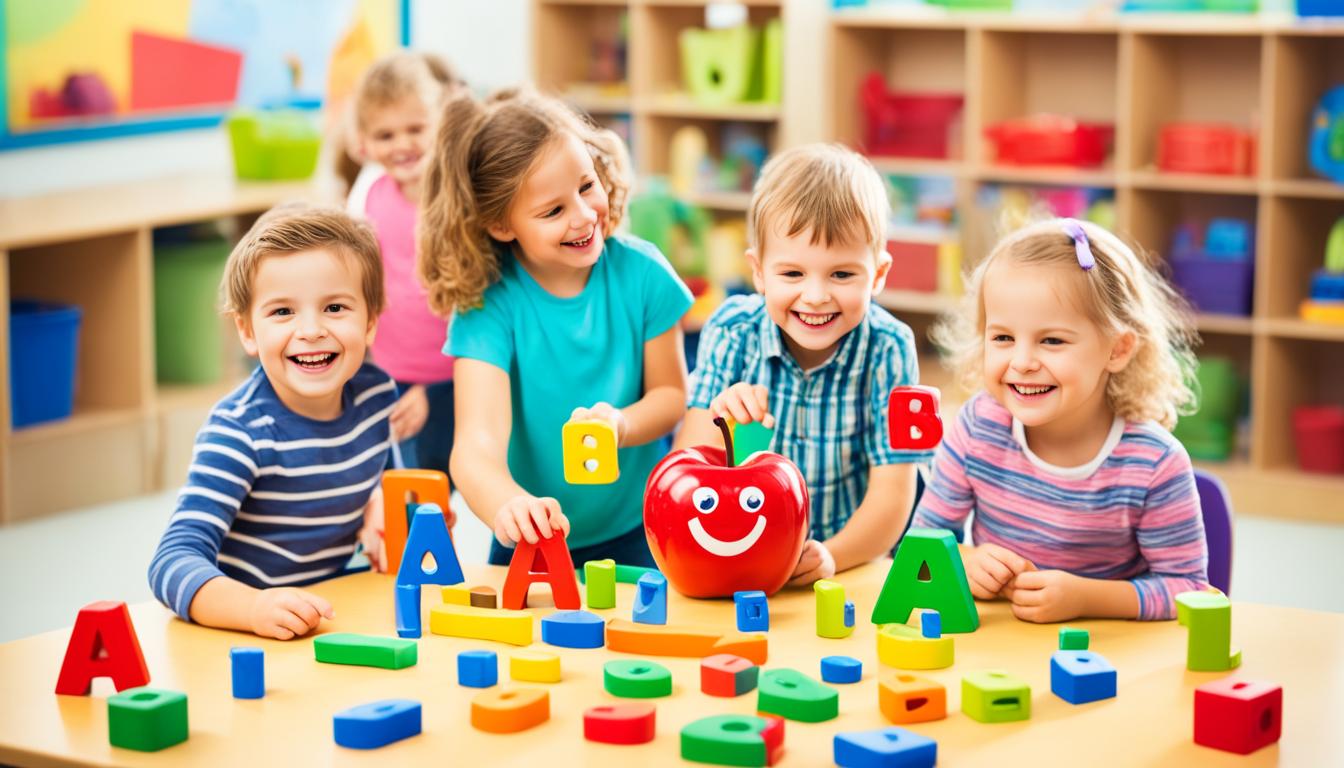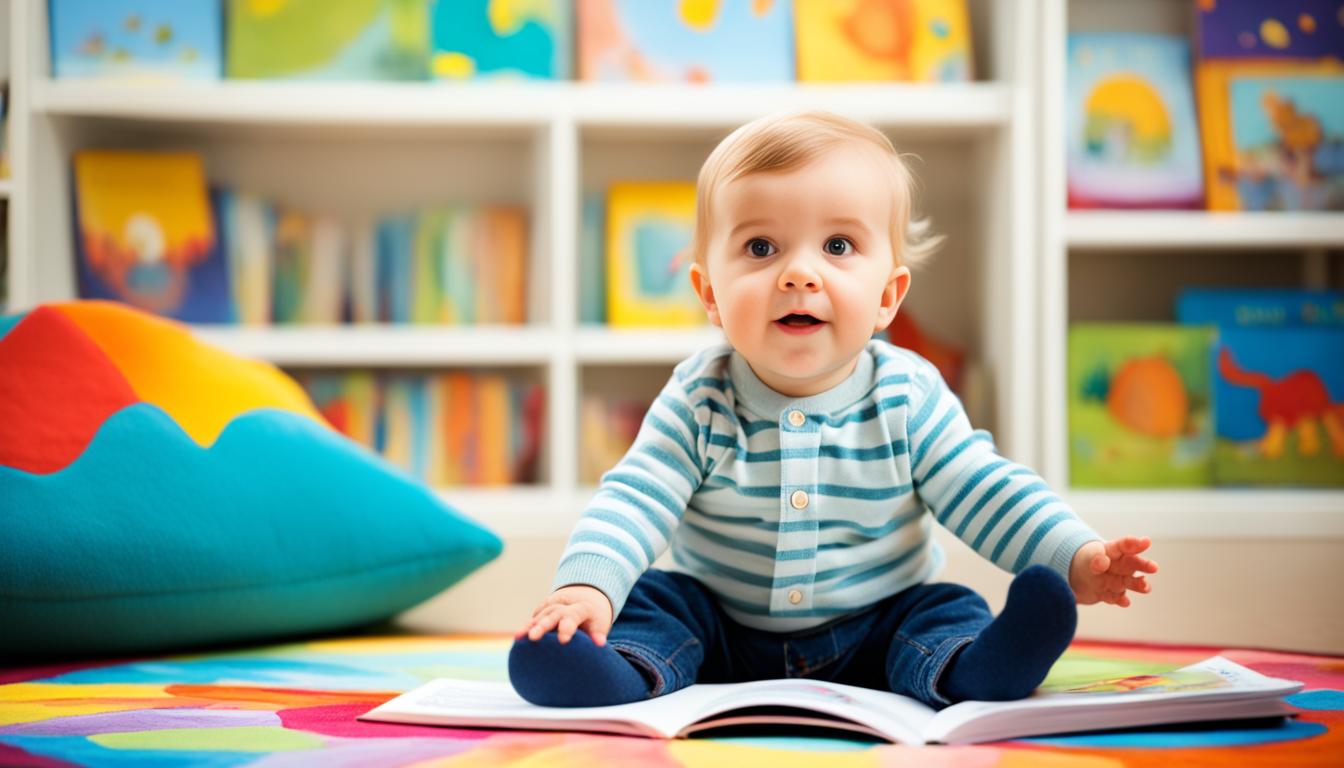Are you aware that mastering the alphabet can offer kids an engaging and fun-filled journey? The era of boring drills and mechanical memorization is behind us. Now, there’s a variety of entertaining methods and activities designed to captivate children as they delve into the realm of letters. Whether it’s through sensory bins or tracing activities, there are plenty of approaches to turn alphabet learning into an interactive and lively experience. Let’s explore some of these methods and find out how they can make learning ABCs an exciting quest!
Key Takeaways:
- Engaging children in fun and interactive alphabet activities can make the learning process enjoyable and memorable.
- Reading alphabet books helps introduce and reinforce letter recognition.
- Sensory bins provide a hands-on and multisensory experience for children to engage in alphabet hunts.
- Letter matching games and letter sorting activities promote letter recognition and fine motor skills.
- Alphabet tracing strips and Q-tip letter cards offer valuable practice for letter formation and fine motor skills.
Read Alphabet Books
Reading alphabet books is a fantastic way to introduce children to the world of letters and help them reinforce letter recognition skills. These books are specially designed to explore the letters of the alphabet in creative and engaging ways, making the learning process fun and enjoyable for young readers.
Alphabet books come in a wide range of formats, from simple and repetitive texts to interactive and rhyming stories. They often incorporate colorful illustrations and captivating characters that bring the letters to life, captivating the attention of young readers. By reading these books, children not only familiarize themselves with the letters but also discover the sounds each letter makes.
“Alphabet books provide a visual and auditory learning experience, making it easier for children to remember the letters and associate them with their sounds”
These books can be a valuable tool for building a strong foundation in literacy. By engaging children in the story and encouraging them to actively participate in the reading process, alphabet books promote language development, vocabulary expansion, and early reading skills. They also serve as a springboard for further exploration of words and storytelling.
“Alphabet books ignite a love for reading and foster a lifelong passion for literacy”
To make the most of alphabet books, parents and educators can incorporate interactive elements into the reading experience. This can include asking questions, pointing out specific letters, and encouraging children to repeat the sounds they hear. By actively engaging with the text, children deepen their understanding of letters and enhance their overall literacy skills.
So, whether it’s a classic ABC book or a modern take on letter exploration, reading alphabet books is a delightful way to enhance children’s letter recognition, language development, and overall love for reading.
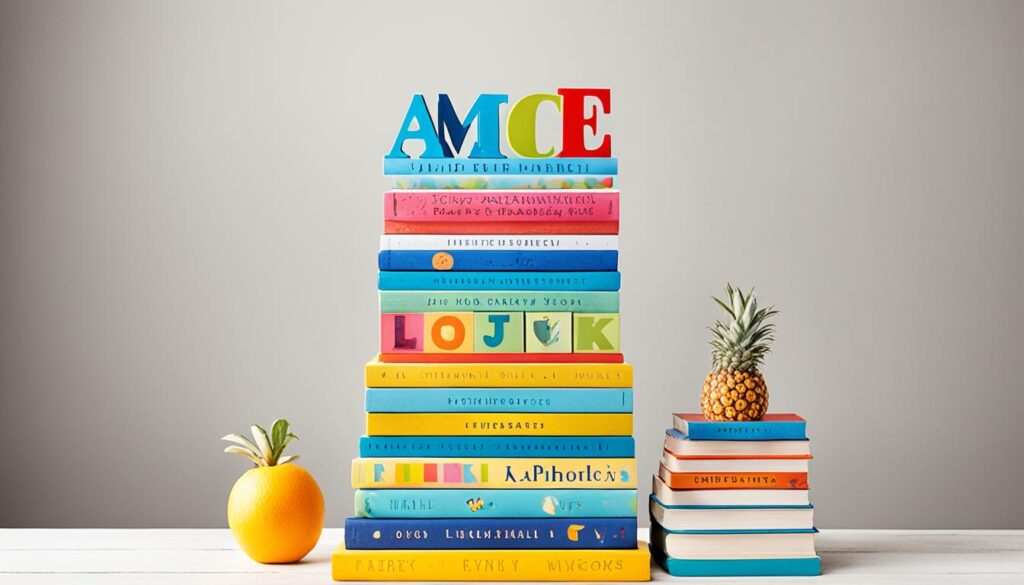
| Benefits of Reading Alphabet Books | |
|---|---|
| Enhances letter recognition skills | ✓ |
| Develops language and vocabulary | ✓ |
| Promotes early reading skills | ✓ |
| Encourages interactive learning | ✓ |
| Ignites a love for reading | ✓ |
Sensory Bin Alphabet Hunt
One of the most engaging and hands-on activities for learning the alphabet is the Sensory Bin Alphabet Hunt. This activity combines the exploration of materials in a sensory bin with the excitement of discovering hidden alphabet bins. By incorporating sensory elements and an element of discovery, children can enhance their letter recognition skills while having fun.
To set up the sensory bin, you’ll need materials such as sand, rice, or cornmeal. These materials provide a tactile and multisensory experience for children. Fill a large bin with the chosen material, making sure it covers the bottom evenly. This will serve as the base for the alphabet hunt.
Next, hide plastic alphabet bins in the sensory bin. These bins can be labeled with uppercase or lowercase letters to match the child’s learning level. The bins can be buried or partially covered in the sensory material, creating a sense of anticipation and excitement for the children.
Once the sensory bin is set up, children can begin their alphabet hunt. Instruct them to dig through the sensory material, searching for the hidden alphabet bins. As they find each bin, they can identify the letter, say its name and sound, and keep track of their discoveries.
The sensory bin alphabet hunt provides a multisensory experience that engages children in letter recognition. The tactile sensation of feeling the sensory material enhances their understanding of letter shapes, while the excitement of searching for hidden treasures adds an element of playfulness to the learning process.
This activity can be adapted to different levels of letter recognition. For beginners, focus on a smaller set of letters and provide visual cues such as pictures of objects starting with those letters. For more advanced learners, increase the number of alphabet bins and encourage them to match uppercase and lowercase letters.
Overall, the Sensory Bin Alphabet Hunt is a fun and interactive way to promote letter recognition while stimulating multiple senses. It encourages children to actively participate in their own learning journey and helps them develop a strong foundation in letter recognition and literacy skills.

Letter Matching Games
When it comes to reinforcing letter recognition, letter matching games are a simple yet effective tool. These games not only help children identify letters but also improve their fine motor skills. Here are two fun letter matching game ideas:
1. Matching Uppercase and Lowercase Letters
“Matching uppercase and lowercase letters on large dried white beans.”
One idea is to write uppercase letters on one set of large dried white beans and lowercase letters on another set. Then, ask children to match the beans with the corresponding uppercase and lowercase letters. This tactile activity not only encourages letter identification but also strengthens fine motor skills. Here’s an example of how the game can be set up:
| Uppercase Beans | Lowercase Beans |
|---|---|
| A | a |
| B | b |
| C | c |
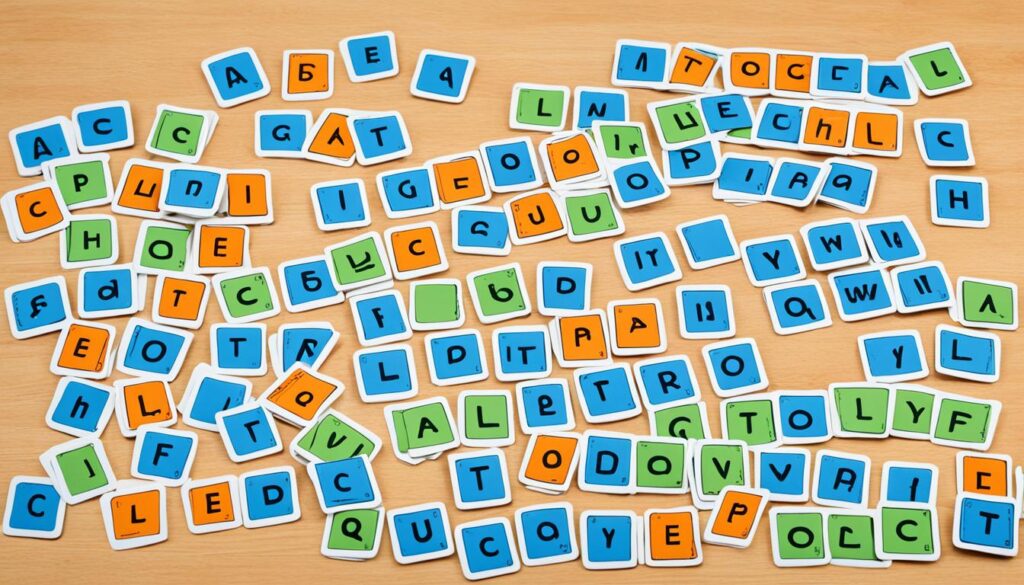
2. Alphabetical Order Line-Up
“Giving each student a card with one letter and having them line up in alphabetical order.”
Another engaging letter matching game involves giving each student a card with one letter written on it and having them line up in alphabetical order. This activity not only reinforces letter recognition but also encourages teamwork and cooperation. Here’s an example of how the game can be played:
- Assign each student a card with a randomly assigned letter.
- Have the students arrange themselves in a line, ensuring the cards are in alphabetical order.
- Encourage the students to name the letters as they arrange themselves.
By playing these letter matching games, children can have fun while sharpening their letter recognition skills and improving their fine motor abilities.
Uppercase and Lowercase Letter Sorting
One important aspect of learning the alphabet is understanding the relationship between uppercase and lowercase letters. To facilitate this concept, we can introduce an engaging activity that involves sorting uppercase and lowercase letters.
To begin, provide students with divided containers labeled with lowercase letters, such as a tray with compartments labeled “a,” “b,” “c,” and so on. Then, give them a collection of uppercase alphabet beads or tiles.
Ask the students to match each uppercase letter with its corresponding lowercase letter and place them in the correct compartment. This hands-on activity not only promotes letter recognition but also reinforces the connection between uppercase and lowercase letters.
Here is an example of how the activity can be set up:
| Lowercase Letters | Uppercase Alphabet Beads |
|---|---|
| a | A |
| b | B |
| c | C |
| d | D |
This activity not only enhances letter recognition skills but also improves students’ understanding of the relationship between uppercase and lowercase letters, which is vital for building early literacy skills. By incorporating interactive exercises into the learning process, we can ensure that students retain information more effectively and develop a solid foundation in literacy.
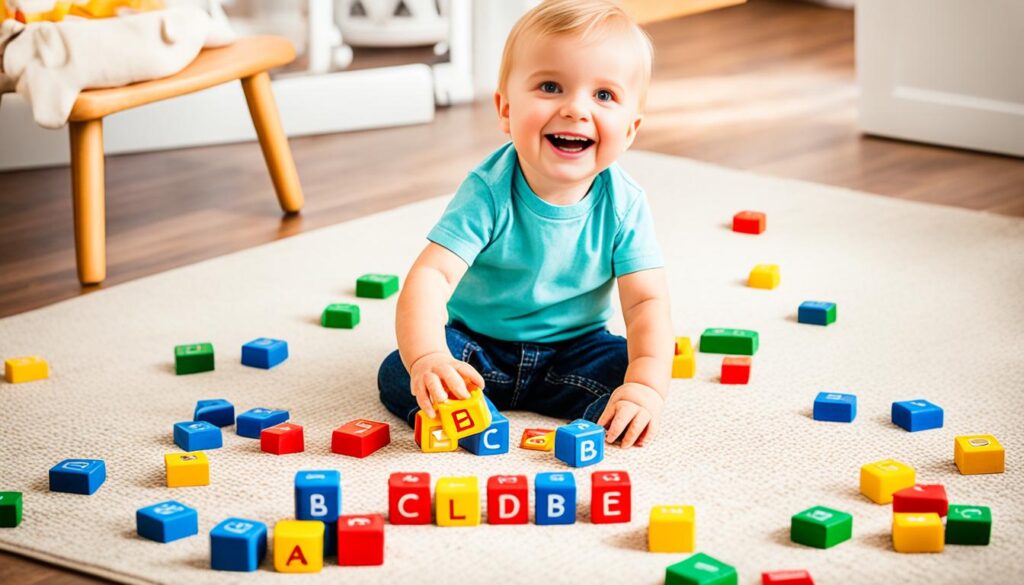
Alphabet Tracing Strips
Repetition is key when learning a new skill, and alphabet tracing strips can provide valuable practice for children. These strips feature dotted lines for each letter, allowing children to trace the letters multiple times. By engaging in this activity, children can improve their handwriting and fine motor skills while familiarizing themselves with the shapes and forms of each letter.
Alphabet tracing strips are an effective way to reinforce letter formation and promote proper handwriting techniques. By tracing the letters repeatedly, children develop muscle memory and gain confidence in their ability to write each letter accurately.
Benefits of Alphabet Tracing Strips:
- Enhances fine motor skills: Alphabet tracing requires precise hand movements and control, which can help children develop and refine their fine motor skills.
- Improves handwriting: By following the dotted lines, children learn the correct formation of each letter, leading to improved handwriting skills.
- Boosts letter recognition: Tracing the letters repeatedly helps children recognize and memorize the shapes and forms of each letter, facilitating letter recognition.
- Fosters concentration and focus: Tracing each letter demands concentration and focus, promoting the development of these essential skills.
- Provides multisensory learning: The tactile experience of tracing the letters engages multiple senses and enhances the learning experience.
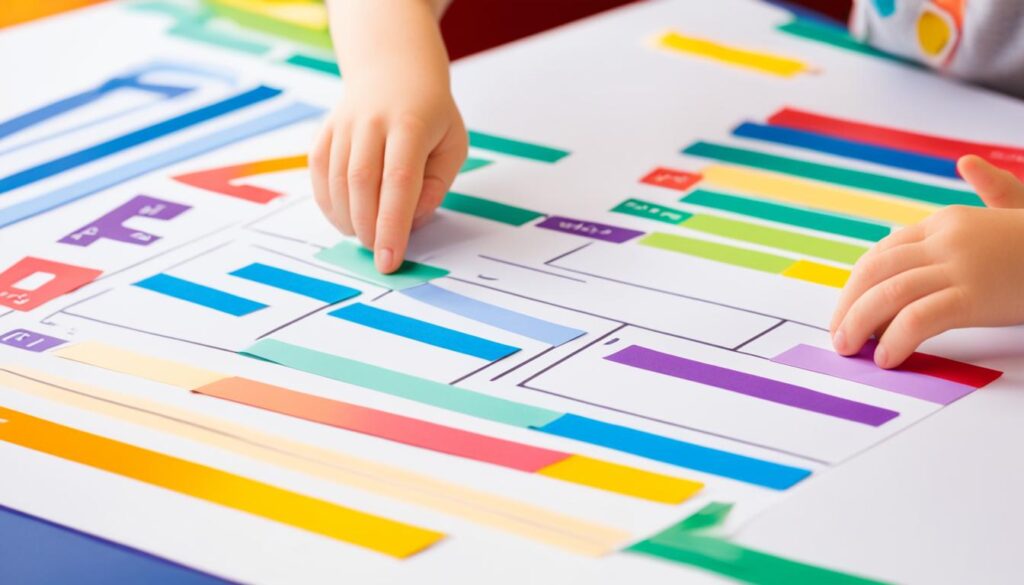
| Benefits of Alphabet Tracing Strips |
|---|
| Enhances fine motor skills |
| Improves handwriting |
| Boosts letter recognition |
| Fosters concentration and focus |
| Provides multisensory learning |
Sticky Notes Letter Sorting Game
Looking for a creative way to make letter sorting exciting? Why not try the Sticky Notes Letter Sorting Game! This interactive activity combines the fun of sticky notes with the educational benefits of letter recognition and sorting.
Here’s how to play:
- Write individual letters on sticky notes. You can use a variety of colors to make it more visually appealing.
- Place the sticky notes around the house or on stair steps. Be sure to hide them in different locations to add an element of surprise.
- Invite children to find the sticky notes and sort them based on various criteria. For example, they can sort the letters by lowercase and uppercase, letters in their name, straight lines versus curved lines, consonants, and vowels.
This game not only promotes letter recognition but also helps children develop critical thinking skills as they sort and categorize the letters. It adds an element of fun and variety to traditional letter recognition and sorting activities, making the learning process more engaging and enjoyable.
So, grab some sticky notes and get ready for an exciting letter sorting adventure!
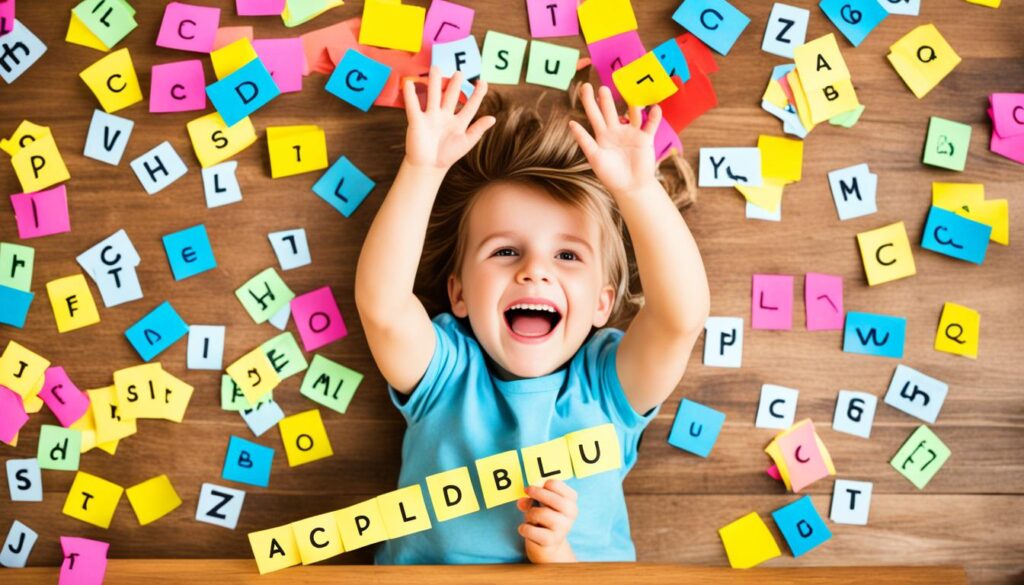
| Benefits of the Sticky Notes Letter Sorting Game: |
|---|
| Enhances letter recognition |
| Develops critical thinking skills |
| Engages children in interactive learning |
| Encourages fine motor skills |
Q-Tip Letter Cards
One fun and engaging activity for practicing letter formation, fine motor skills, and letter recognition is using Q-tip Letter Cards. Children can dip Q-tips in paint and carefully fill in the letters on the cards, creating colorful and textured letter formations. This hands-on activity not only helps children become familiar with the shapes and lines of each letter but also enhances their fine motor skills.
For added variety and sensory stimulation, children can experiment with different tools besides Q-tips. Pencil erasers or pushpins can be used to create different textures and variations in letter tracing and formation, making the activity even more exciting for young learners.
Through the process of filling in the letters on Q-tip Letter Cards, children actively practice their letter formation and recognition skills, while also developing their fine motor skills necessary for tasks such as writing. As children engage in this creative and interactive activity, they reinforce their understanding of the alphabet, allowing for a fun and effective learning experience.
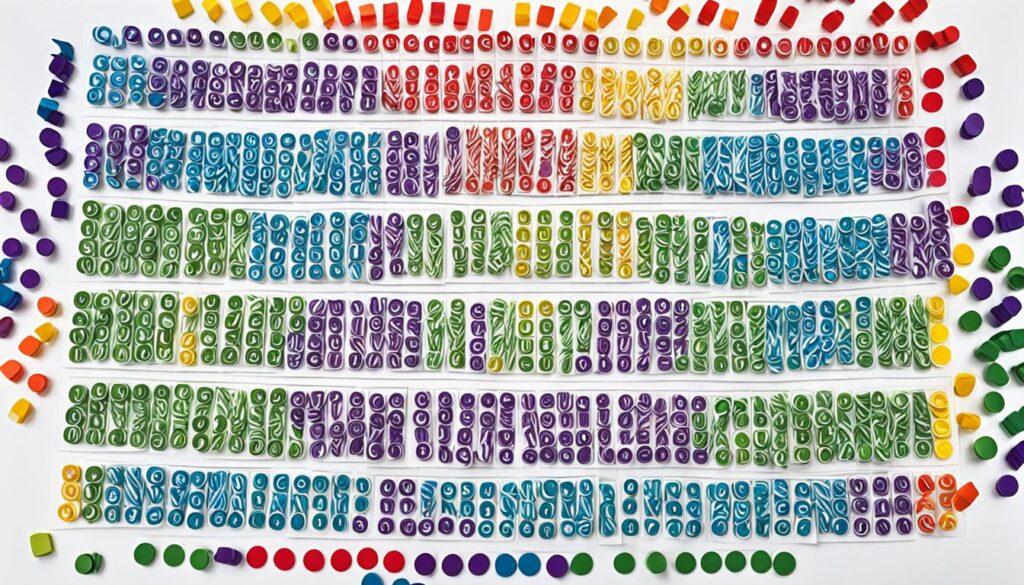
| Benefits of Q-Tip Letter Cards: |
|---|
| 1. Practice letter formation. |
| 2. Improve fine motor skills. |
| 3. Enhance letter recognition. |
Alphabet Bead Stringing
If you’re looking for a fun activity that can help children learn their letters, alphabet bead stringing is the way to go. By using pipe cleaners and a variety of alphabet beads, children can not only practice letter recognition but also create their own unique bead strings. This hands-on activity combines fine motor skills with letter recognition, making learning the alphabet enjoyable and engaging.
Materials Needed:
- Pipe cleaners
- Large and small alphabet beads
To get started, provide each child with a pipe cleaner and a selection of alphabet beads. Encourage them to pick one bead at a time and string it onto the pipe cleaner, creating a pattern or spelling out simple words if desired. As they select each bead, prompt them to say the letter out loud, reinforcing letter recognition and letter-sound correspondence.
This activity not only enhances letter recognition but also helps improve fine motor skills as children manipulate and thread the beads onto the pipe cleaner. It can be tailored to different skill levels, allowing younger children to focus on basic letter recognition while older children can practice spelling and creating more complex patterns.

Through alphabet bead stringing, children can engage their senses, strengthen their hand-eye coordination, and boost their letter recognition skills in a fun and interactive way. This activity fosters creativity and allows children to take ownership of their learning as they design their bead strings.
| Benefits of Alphabet Bead Stringing: | Skills Developed: |
|---|---|
| 1. Enhances letter recognition | – Letter recognition |
| 2. Improves fine motor skills | – Fine motor skills |
| 3. Encourages creativity and self-expression | – Creativity |
| 4. Reinforces letter-sound correspondence | – Letter-sound correspondence |
| 5. Stimulates hand-eye coordination | – Hand-eye coordination |
Giving children the opportunity to engage in hands-on activities like alphabet bead stringing can greatly enhance their letter recognition skills and overall understanding of the alphabet. It provides an interactive and enjoyable learning experience that sets a strong foundation for literacy development.
Shaving Cream Letter Writing
One of the most engaging and sensory activities for children to practice letter formation is through shaving cream letter writing. This activity allows children to use their senses while creating and exploring the letters of the alphabet. By inviting children to write letters in a tray or directly on a table covered with shaving cream, they can experience the tactile sensation of the cream as they practice their handwriting skills.
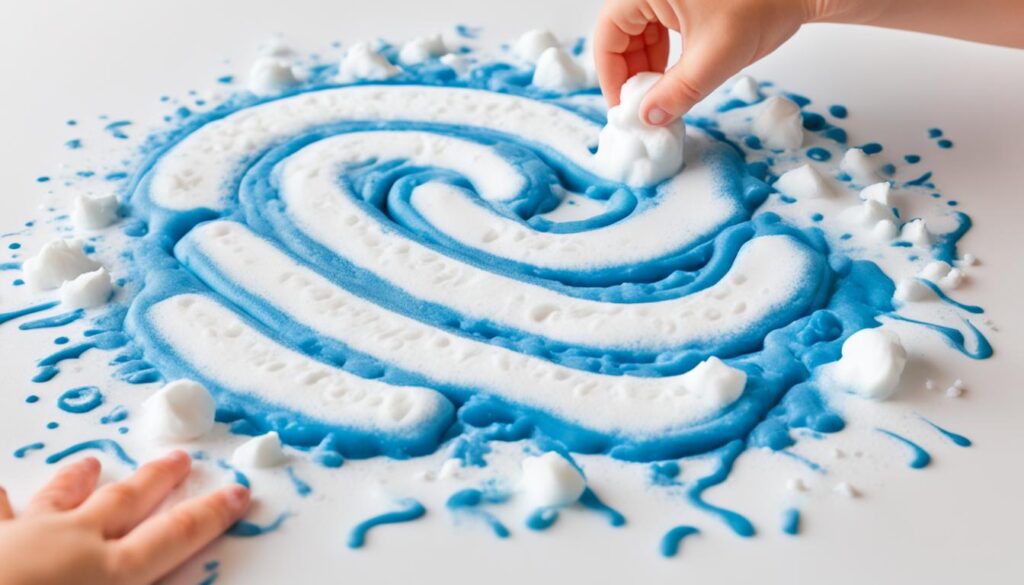
The squishy texture of the shaving cream provides a fun and interactive learning experience as children use their fingers to shape and mold the letters. It also enhances their fine motor skills, helping them develop hand-eye coordination and control over their writing utensils.
As children smooth out the cream and start again, they have the opportunity to continuously practice writing the letters of the alphabet. This repetitive practice promotes letter recognition and reinforces the correct letter formation, enabling children to develop a strong foundation in handwriting skills.
Shaving cream letter writing also adds an element of excitement and creativity to learning the alphabet. Children can experiment with different writing styles, sizes, and even mix colors in the cream for a vibrant and visually appealing letter writing experience.
This sensory play activity not only makes letter formation more enjoyable but also accommodates different learning styles. Visual learners can see the letters they write, while kinesthetic learners can physically engage with the shaving cream as they write. Additionally, the multisensory nature of this activity can benefit children with sensory processing differences, as it provides a calming and tactile experience.
Overall, shaving cream letter writing is a fantastic activity that combines sensory play with letter formation practice. It engages children’s senses, enhances their fine motor skills, and promotes letter recognition in a fun and interactive way.
Outdoor Alphabet Chalk Activities
Let’s take the fun of learning outside with some creative sidewalk chalk activities! Sidewalk chalk is not only a great way to engage children in outdoor play, but it also provides an excellent opportunity for letter formation and recognition. By combining kinesthetic movement with the practice of writing letters, children can enjoy an interactive learning experience while playing outside.
Writing Letters on the Ground
Encourage children to use sidewalk chalk to write letters directly on the ground. They can start with simple uppercase and lowercase letters and gradually move on to more complex ones as they become more confident. As they trace the letters with their hands, they engage their fine motor skills and reinforce letter formation.
Example:
With a piece of sidewalk chalk, we can draw a large uppercase letter A on the ground. As children trace the letter with their fingers or a stick, they can say its name and the corresponding sound, reinforcing their letter recognition and phonetic knowledge.
Letter Cards on an O-ring
Create letter cards using construction paper or cardboard, and attach them to an O-ring. Children can take the O-ring outside and use it as a portable letter display. They can arrange the cards in alphabetical order or use them as a reference while writing letters on the ground. This activity adds an element of fun and mobility to outdoor letter learning.
Example:
We can create letter cards from colorful construction paper and attach them to an O-ring. As children explore the backyard or park, they can refer to the cards and practice writing the corresponding letters nearby. This hands-on approach makes letter recognition more enjoyable and memorable.
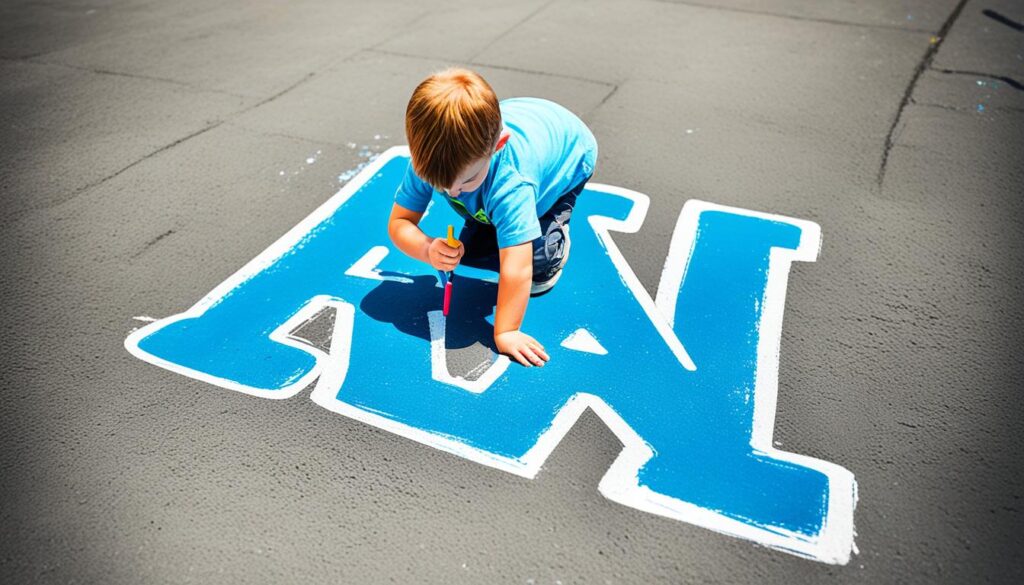
Incorporating sidewalk chalk into outdoor play not only promotes letter formation but also encourages children to make connections between the physical act of writing and the shapes and sounds of the letters. Letting children engage in learning through play instills a love for letters and fosters a positive learning experience. Enjoy the sunshine and watch as letters come to life with every stroke of the chalk!
Conclusion
When it comes to teaching children the alphabet, engagement is key. By incorporating a variety of fun and interactive activities, educators and parents can create an enjoyable learning experience that enhances letter recognition and fosters a love for literacy. Here are some effective techniques that can make the process of learning the alphabet a memorable adventure:
Firstly, alphabet books provide a fantastic way to introduce and reinforce letter recognition. These books are creatively designed to captivate young minds, making the learning process more enjoyable and memorable. Through captivating stories and vibrant illustrations, children can immerse themselves in the world of letters, expanding their vocabulary and strengthening their literacy skills.
Another engaging activity is the use of sensory bins. By creating a sensory experience with materials like sand, rice, or cornmeal, children can explore and discover letters hidden within. This hands-on approach promotes hands-on learning, as children identify letters, match them, and explore their sounds. The excitement of an alphabet hunt in a sensory bin adds a playful element to learning the alphabet.
In addition, tracing strips are a simple yet effective tool for letter formation and fine motor skill development. These strips feature dotted lines for each letter, encouraging children to practice tracing them multiple times. The repetitive nature of this activity helps children become familiar with the shapes and forms of each letter, enhancing their handwriting skills and strengthening their fine motor control.
Are the Fun Techniques for Learning Math Similar to Those for Learning the Alphabet?
When it comes to learning numbers made fun, the techniques can be similar to learning the alphabet. For both, using games, songs, and visual aids can make the process more enjoyable for children. These interactive methods can help kids grasp mathematical concepts and alphabetic principles in a more engaging way.
How Can Fun and Easy Techniques be Used to Teach Newborns to Drink from Bottles?
When teaching newborns to drink from bottles, using the best bottles for breastfed babies is crucial. Fun and easy techniques, such as paced bottle feeding and offering the bottle when the baby is calm, can help the transition. It’s important to be patient and offer lots of encouragement during this process.
FAQ
How can I make learning the alphabet more enjoyable for my child?
Engage your child in fun and interactive activities such as reading alphabet books, setting up sensory bins, playing letter matching games, using tracing strips, and more.
What are some good books to introduce and reinforce letter recognition?
There are numerous alphabet books available that explore the letters of the alphabet in creative and engaging ways. Reading alphabet books can familiarize children with the letters and their sounds, making the learning process more enjoyable.
How can I promote letter recognition through sensory play?
Set up a sensory bin with materials like sand, rice, or cornmeal and hide plastic alphabet bins in it. Children can engage in an alphabet hunt, finding letters, identifying their names and sounds, and keeping track of their discoveries.
What letter matching games can I play with my child?
Write uppercase and lowercase letters on large dried white beans and ask children to match them. You can also give each student a card with one letter written on it and have them line up in alphabetical order.
How can I reinforce the connection between uppercase and lowercase letters?
Provide students with divided containers labeled with lowercase letters and give them a collection of uppercase alphabet beads. They can place the corresponding letter in the correct compartment, promoting letter recognition.
How can I help my child improve their handwriting while learning the alphabet?
Alphabet tracing strips with dotted lines for each letter allow children to trace the letters multiple times, improving their handwriting and fine motor skills.
Are there any games that involve letter sorting?
You can use sticky notes and have children sort letters based on various criteria such as lowercase and uppercase, letters in their name, straight lines versus curved lines, consonants, and vowels.
What are Q-tip letter cards?
Q-tip letter cards are cards with letters on them that children can fill in using Q-tips dipped in paint. This activity helps them practice letter formation, fine motor skills, and letter recognition.
How can I use alphabet beads to help my child learn their letters?
Stringing alphabet beads on pipe cleaners allows children to create their own unique bead strings while practicing letter recognition and fine motor skills.
How can I make letter formation practice more engaging?
Squirt shaving cream on a table or tray and invite children to write letters in the cream. This sensory activity allows them to practice letter formation while engaging their senses.
How can I incorporate letter formation practice into outdoor play?
Use sidewalk chalk to write letters on the ground or on letter cards attached to an O-ring. This activity allows children to connect kinesthetic movement with letter formation while enjoying the outdoors.
